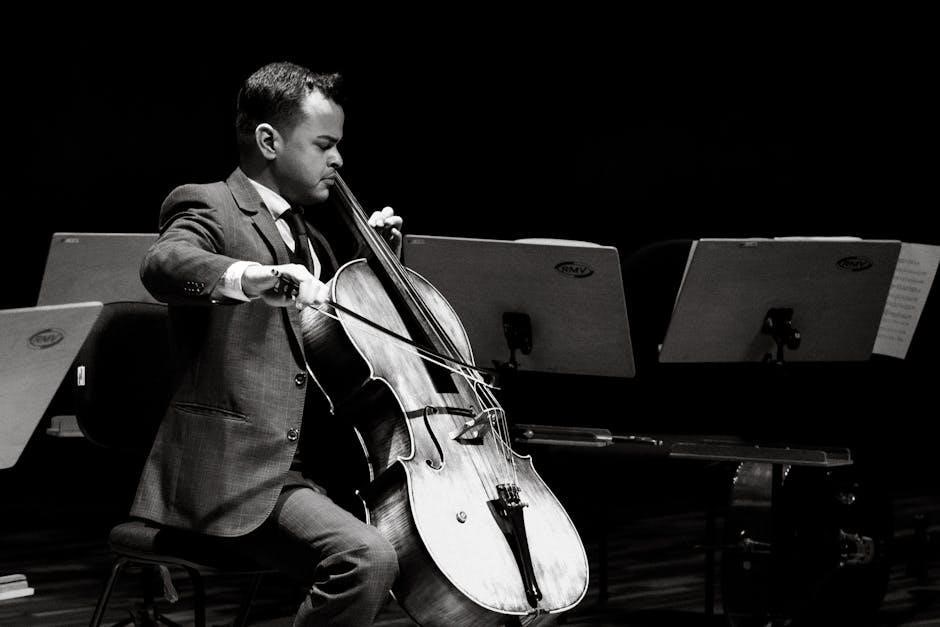Bach’s Toccata and Fugue in D Minor (BWV 565) is a renowned organ composition, blending dramatic improvisation and structured counterpoint. Its popularity grew after Felix Mendelssohn’s 1833 publication, making it a cultural icon, though its authorship is debated. The piece’s dramatic effect, enhanced by D Minor, has captivated audiences and inspired media appearances, solidifying its place in classical music history.
Overview of the Composition
Bach’s Toccata and Fugue in D Minor (BWV 565) is a celebrated organ work, blending free-form improvisation and structured counterpoint. The piece opens with a dramatic toccata, showcasing virtuosic organ technique, followed by a complex fugue with interwoven themes. Composed in D Minor, it leverages the key’s dramatic intensity. While its exact date is uncertain, scholars suggest it was written between 1704 and the 1740s. Attributed to Bach, its manuscript was first copied by Johannes Ringk, fueling debates about its authorship. Published by Felix Mendelssohn in 1833, it gained widespread popularity, becoming a cornerstone of organ repertoire.
Historical Context and Significance
Toccata and Fugue in D Minor (BWV 565) holds a unique place in music history, despite debates over its authorship. First published by Felix Mendelssohn in 1833, it gained widespread recognition and became synonymous with Bach’s organ repertoire. The piece reflects the Baroque era’s emphasis on dramatic contrast and technical virtuosity. Its dramatic structure and use of D Minor for heightened emotion solidified its reputation as a cornerstone of organ music. Despite scholarly doubts about Bach’s authorship, its cultural impact remains undiminished, making it a timeless classic in classical music.

The Composer and Authorship Debate
The Toccata and Fugue in D Minor is traditionally attributed to Johann Sebastian Bach, but scholars debate its authorship due to ambiguous manuscript sources and stylistic differences.
Johann Sebastian Bach’s Attribution
The Toccata and Fugue in D Minor (BWV 565) is traditionally attributed to Johann Sebastian Bach, with its manuscript first appearing in the 19th century. Bach’s authorship was questioned in the 20th century, with some scholars suggesting it may have been composed by another organist, possibly earlier. Despite debates, Bach’s mastery of counterpoint and organ technique supports the attribution, making it a cornerstone of his organ repertoire, widely celebrated for its dramatic intensity and technical brilliance.
Scholarly Controversies About the Piece’s Origin
Scholars have debated the origins of the Toccata and Fugue in D Minor, with some questioning Bach’s authorship. The earliest manuscript, copied by Johannes Ringk, lacks direct attribution to Bach; Stylistic differences, such as unconventional harmonic progressions, have fueled speculation about its true composer. While some argue it aligns with Bach’s later works, others propose it may stem from a younger composer influenced by his style. This uncertainty has not diminished its popularity, as it remains a celebrated piece in the organ repertoire.
Structure and Form of the Toccata and Fugue
The Toccata and Fugue in D Minor combines free-form improvisation with structured counterpoint, creating a dramatic contrast. The Toccata’s virtuosic flair and the Fugue’s intricate chase showcase Bach’s mastery of form and tonality.
The Toccata Section: Free-Form Improvisation
The Toccata section of Bach’s D Minor piece is a dazzling display of free-form improvisation, characterized by dramatic flourishes and sudden tempo shifts. Its virtuosic nature, with flashy fingerwork and pedal passages, creates an intense, mysterious atmosphere. The section’s structure is fluid, allowing for expressive freedom while maintaining a sense of controlled chaos. The use of D Minor enhances its dramatic impact, setting the stage for the contrasting rigor of the Fugue. This opening section is a testament to Bach’s mastery of the organ’s capabilities, blending spontaneity with compositional brilliance.
The Fugue Section: A Musical Chase
The Fugue section of Bach’s Toccata and Fugue in D Minor is a masterful example of contrapuntal writing, where a central theme is pursued by interweaving voices. This “musical chase” creates a sense of relentless energy, with each voice entering at strategic intervals. The structure is tightly knit, featuring dramatic key changes and layered complexity. As the Fugue progresses, the texture thickens, and the interplay of voices builds tension, culminating in a triumphant resolution. The section’s intricate design and emotional depth highlight Bach’s genius in blending order with expressive freedom.

Key Features and Musical Elements
The Toccata and Fugue in D Minor features dramatic contrasts, with a free-form toccata showcasing virtuosic improvisation and a structured fugue highlighting intricate counterpoint. The use of D Minor intensifies the emotional depth, creating a dynamic interplay of light and darkness through the organ’s full sonic range, from powerful bass lines to soaring treble melodies, all while maintaining a cohesive and masterful musical architecture.
The Role of the Organ in the Composition
The organ is central to Bach’s Toccata and Fugue in D Minor, leveraging its unique capabilities to create a dramatic soundscape. The instrument’s vast range, from deep bass to high treble, allows for contrasting dynamics and textures. The toccata’s virtuosic passages exploit the organ’s manual dexterity, while the fugue’s intricate counterpoint is enriched by distinct voice pairings. The organ’s versatility transforms it into an ‘orchestra,’ with each pipe voice contributing to the piece’s grandeur and emotional intensity, making it a cornerstone of organ repertoire.
Use of D Minor for Dramatic Effect
Bach’s choice of D Minor in the Toccata and Fugue creates an atmosphere of intensity and drama. This key, often associated with solemnity and grandeur, enhances the piece’s emotional depth. The dramatic entrance of the toccata, with its bold gestures and dynamic contrasts, is amplified by the D Minor tonality. The fugue’s intricate counterpoint and harmonic progression further leverage the key’s expressive qualities, creating a sense of tension and resolution that captivates listeners, making D Minor integral to the composition’s enduring impact.

Sheet Music and Performance Resources
Sheet music for Bach’s Toccata and Fugue in D Minor is available in PDF for piano, guitar, and flute. Performance tips and study materials are also accessible online.
Availability of PDF Scores for Download
PDF scores of Bach’s Toccata and Fugue in D Minor are widely available for download. Platforms like ClassicalBeatz and sheet music communities offer free downloads for piano, guitar, and flute arrangements. Musicians can access these scores to study, practice, or perform. Many websites provide high-quality, printable versions, ideal for educational purposes or personal use. These resources are essential for musicians seeking to master Bach’s iconic composition, ensuring accessibility for learners and professionals alike.
Instrumentation and Performance Tips
Toccata and Fugue in D Minor is originally composed for the organ, requiring mastery of pedals and manuals. Organists must navigate complex fingerings and pedal markings, which are often included in PDF scores. Performance tips emphasize maintaining clarity in fast passages and balancing dynamic contrasts. Musicians should practice tempo control and articulation to preserve the piece’s dramatic intensity. PDF arrangements also offer adaptations for piano and other instruments, making the work accessible to a broader range of performers while retaining its iconic organ-centric character.
Cultural and Educational Impact
Bach’s Toccata and Fugue in D Minor has left an indelible mark on culture, appearing in films and media, while its complexity makes it a cornerstone in music education, with PDF scores widely available for study and performance.
Popularity in Modern Media and Culture
Bach’s Toccata and Fugue in D Minor has become a cultural icon, featured in films, TV shows, and even rock music. Its dramatic, haunting melodies make it a favorite for setting eerie or intense scenes. The piece has been used in numerous soundtracks, from horror movies to video game trailers, further cementing its place in popular culture. Its adaptability and emotional impact have made it a staple in modern media, introducing Bach’s genius to new audiences while inspiring countless arrangements and reinterpretations across genres.
Educational Tools and Study Materials
Sheet music for Bach’s Toccata and Fugue in D Minor is widely available as PDF downloads, enabling musicians and students to study and perform the piece. Educational platforms offer flashcards, quizzes, and analyses to aid music theory understanding. Resources like listening guides and structured lessons help break down the composition’s complex structure and historical context. These tools are invaluable for educators and learners, providing a comprehensive approach to mastering Bach’s iconic work and exploring its cultural and musical significance in depth.

Challenges in Performance
The Toccata and Fugue in D Minor poses significant technical challenges, including intricate fingerings, exhausting fugue sections, and demanding pedal techniques, requiring exceptional skill and stamina from performers.
Technical Difficulties for Musicians
The Toccata and Fugue in D Minor presents significant technical challenges, particularly its intricate fingerings, demanding pedal techniques, and exhausting fugue sections. Musicians must master complex tempo fluctuations and precise articulation to maintain clarity. The piece’s dramatic dynamics and rapid arpeggios require exceptional dexterity and stamina, while its lengthy fugue demands sustained concentration and technical precision. Additionally, the interplay between manuals and pedals necessitates a high level of coordination, making it a formidable test of skill for even experienced organists.
Interpretation and Artistic Freedom
The Toccata and Fugue in D Minor offers vast opportunities for interpretative freedom, allowing musicians to imprint their personal style. The free-form toccata section invites creative choices in tempo, dynamics, and articulation, while the fugue provides a structured yet flexible framework for expressive phrasing. Performers can experiment with dramatic contrasts, nuanced pedal techniques, and varied rhythmic emphases, making each rendition unique. This balance of structure and spontaneity ensures the piece remains a timeless canvas for artistic expression and innovation, reflecting the interpreter’s individual musical vision.
